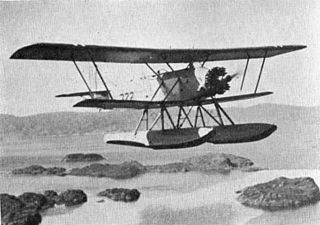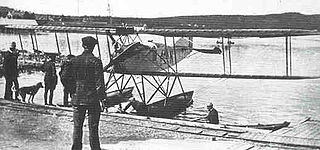
Kristiansand Airport, Kjevik is an international airport serving the city of Kristiansand in Agder county, Norway. The airport is located in the district of Tveit in the Oddernes borough, about 16 kilometers (9.9 mi) by road and 8 kilometers (5.0 mi) by air from the city center of Kristiansand. Operated by the state-owned Avinor, it is the sole airport in Southern Norway with scheduled flights. Kjevik has a 2,035-meter (6,677 ft) runway aligned 03/21 and served 1,061,130 passengers in 2018. Scheduled flights are provided by Scandinavian Airlines, Norwegian Air Shuttle, Widerøe, KLM Cityhopper and Wizz Air. The Royal Norwegian Air Force has a training center at the airport.

The Royal Norwegian Navy Air Service was alongside the Norwegian Army Air Service the forerunner to the modern-day Royal Norwegian Air Force.

The Marinens Flyvebaatfabrikk M.F.12 was a seaplane built in Norway in 1939 as a military trainer aircraft to replace the Norwegian Navy's aging fleet of M.F.8 trainers. Only a single prototype was constructed before Germany's invasion of Norway in 1940. The prototype, M.F.12 F.14 (V), was the last trainer built for the Royal Norwegian Navy Air Service (RNNAS).

The Marinens Flyvebaatfabrikk MF.8 was a military training seaplane built in Norway in the 1920s.

The Marinens Flyvebaatfabrikk M.F.10 was a military trainer seaplane built in Norway in 1929.

The Marinens Flyvebaatfabrikk M.F.1 was a two-seat biplane floatplane, the first aircraft produced by the Royal Norwegian Navy Air Service's aircraft factory Marinens Flyvebaatfabrikk in Horten, built after Maurice Farman's MF.7 design. The construction began in the summer of 1915, with plans borrowed from the Norwegian Army Air Service's aircraft factory at Kjeller.
The Marinens Flyvebaatfabrikk M.F.2 was a two-seat military biplane floatplane produced by Marinens Flyvebaatfabrikk in 1915 and 1916. It was designed by naval captain Halfdan Gyth Dehli, based on former models by French designer Maurice Farman and improvements by Einar Sem-Jacobsen of the Norwegian Army Air Service's aircraft factory Kjeller Flyfabrikk.
The Marinens Flyvebaatfabrikk M.F.3 was a reconnaissance floatplane built by the Royal Norwegian Navy Air Service aircraft factory Marinens Flyvebaatfabrikk in 1917. The aircraft was financed by extraordinary appropriations during the First World War and served until October 1924.
Kristian August Østby was a Norwegian naval aviator.
The Marinens Flyvebaatfabrikk M.F.4 was a biplane floatplane built by the Royal Norwegian Navy Air Service aircraft factory Marinens Flyvebaatfabrikk from 1918. The aircraft was the first purpose-built trainer aircraft in Norwegian service and served until retired in October 1924.
The Marinens Flyvebaatfabrikk M.F.5 was a two-seat biplane floatplane built by the Royal Norwegian Navy Air Service aircraft factory Marinens Flyvebaatfabrikk from 1918. The M.F.5 was the first tractor configuration aircraft designed and built in Norway. During almost eight years of service the M.F.5 was mainly used as a reconnaissance aircraft, although one example saw service as a trainer.
The Marinens Flyvebaatfabrikk M.F.7 was a two-seat biplane floatplane built by the Royal Norwegian Navy Air Service aircraft factory Marinens Flyvebaatfabrikk in 1923. The M.F.7 was designed and employed as a trainer aircraft, and functioned as a temporary solution until a better aircraft was designed. Soon after it entered service, the aircraft factory's experience with the M.F.7 led to the construction of the Marinens Flyvebaatfabrikk M.F.8, which remained in service as the main trainer aircraft of the Royal Norwegian Navy Air Service until the German invasion of Norway in 1940.
The Marinens Flyvebaatfabrikk M.F.6 was a two-seat biplane floatplane built by the Royal Norwegian Navy Air Service aircraft factory Marinens Flyvebaatfabrikk in 1921. The M.F.6 was designed and employed as a trainer aircraft. The type was the last pusher configuration aircraft in service with the Royal Norwegian Navy Air Service. The M.F.6 functioned as a makeshift solution until a more modern tractor configuration aircraft could be built. The type was retired once a more permanent solution to the Royal Norwegian Navy Air Service's training needs was found in mid-1920s.

Tromsø Airport, Skattøra, also known by its military designation Skattøra Naval Air Station was a water aerodrome and air base situated at Skattøra in the city of Tromsø in Tromsø Municipality in Troms county, Norway. Construction began in 1938 and the aerodrome was in use until 1975. At its peak it was the largest water airport in Northern Europe.

Ålesund Airport, Sørneset was a water aerodrome and later heliport situated at Nørvevika and later Sørneset in Ålesund, Norway. The airport was, to a varying degree, used between 1929 and 1979. It has since been demolished.
Sørfly A/S was a general aviation airline based in Kristiansand, Norway. It operated from 1946 to 1962 with a base at Kristiansand Airport, Kjevik. Sørfly operated a fleet of three Auster Autocrats, a Republic Seabee and a Miles Gemini.

Haugesund Naval Air Station was a military water aerodrome situated at Avaldsnes in Karmøy in the outskirts of Haugesund, Norway. The air base was operated by the Royal Norwegian Navy Air Service from 17 November 1918 to 7 April 1919. The Naval air station consisted of three portable hangars, a barracks and an outhouse.

Arendal Airport, Rådhuskaien was a water aerodrome in Arendal, Norway, which operated between 1935 and 1939. Situated at Rådhuskaien, it served the scheduled coastal seaplane service operated by Norwegian Air Lines.

Mandal Airfield was a military air base situated at Vestnes in Lindesnes municipality, Norway. It featured a wooden runway measuring 1,520 by 80 meters. Built by the German Luftwaffe in 1940 after Nazi Germany occupied Norway, it remained in use for the rest of the Second World War. Lista Air Station opened in April 1941, after which Mandal remained only a reserve airfield. A 1950 proposal to rejuvenate it as a civilian airport was turned down by the municipal council.

Kristiansand Airport, Kongsgårdbukta was a water airport serving Kristiansand, Norway, from 1934 to 1939. Situated at Kongsgårdbukta, it consisted of a floating dock and a small terminal building. Widerøe served the airport the first year, thereafter flights were carried out by Norwegian Air Lines. The airport was closed for the opening of Kristiansand Airport, Kjevik.








